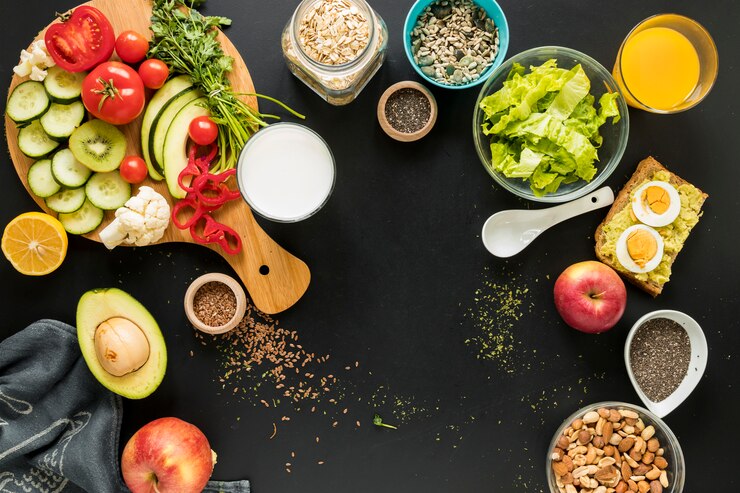Step into the realm of Circular Nutrition, where food goes beyond mere sustenance and becomes a powerful force for sustainability and well-being. Join us on a journey through the Food Universe as we unveil the secrets of circular food systems and explore how they can revolutionize our diets, our health, and our planet. Get ready to discover a new way of nourishing both body and Earth in harmony – it’s time to embrace Circular Nutrition!
Understanding the Concept of Circular Food Systems
Have you ever wondered about the concept of circular food systems and how they can revolutionize our approach to nutrition? Circular food systems aim to create a sustainable cycle where resources are used efficiently, waste is minimized, and the environment is preserved. It’s all about closing the loop and ensuring that nothing goes to waste in the production and consumption of food.
In a circular food system, organic waste from one process becomes a valuable input for another. This means embracing practices like composting, recycling nutrients, and reducing reliance on single-use packaging. By adopting this holistic approach, we can not only nourish ourselves but also take care of the planet for future generations.
Circular food systems encourage us to think beyond traditional linear models of production and consumption. Instead of viewing resources as finite, we see them as part of an interconnected web where every action has an impact. It’s about reimagining our relationship with food and embracing sustainability at its core.
Benefits of Implementing Circular Nutrition in our Diets
Imagine a world where the food we eat not only nourishes our bodies but also sustains the planet. Circular nutrition offers precisely that – a way to benefit both ourselves and the environment through our dietary choices.
By embracing circular nutrition, we can reduce food waste by utilizing all parts of ingredients, promoting sustainability in our food system. This approach encourages us to be more mindful of how we source, consume, and dispose of food.
Incorporating circular foods into our diets means enjoying seasonal produce, supporting local farmers, and choosing whole foods over processed alternatives. This shift not only benefits our health but also strengthens community connections and reduces carbon footprints.
Moreover, adopting a circular diet allows us to explore diverse recipes and culinary traditions while reducing reliance on single-use packaging and industrial farming practices. The ripple effects of these small changes can create significant positive impacts on global ecosystems.
Examples of Circular Foods and Recipes
In the world of circular nutrition, incorporating diverse and sustainable foods is key to creating a balanced diet. Some examples of circular foods include seasonal fruits and vegetables that are locally sourced, reducing carbon footprint while supporting local farmers. Whole grains like quinoa or barley are also great options as they are nutrient-dense and have a lower environmental impact compared to processed grains.
Legumes such as lentils and chickpeas are not only packed with protein but also help fix nitrogen in the soil, promoting healthier crop growth. Incorporating plant-based proteins like tofu or tempeh into your meals can further enhance the sustainability of your diet by reducing reliance on animal products.
When it comes to recipes, think about preparing dishes like vegetable stir-fries using leftover produce or making hearty soups with ingredients that might otherwise go to waste. Get creative with your cooking and embrace the versatility of circular foods in every meal you make!
How to Incorporate Circular Nutrition into Your Daily Routine
Are you ready to embrace circular nutrition and revolutionize your daily eating habits? Incorporating this sustainable approach into your routine is easier than you think. Start by diversifying your plate with a variety of whole foods that are locally sourced and in season.
Consider incorporating more plant-based meals into your diet, such as hearty salads, vegetable stir-fries, or bean-rich stews. Not only are these options good for the planet, but they can also be delicious and nutritious.
Another way to incorporate circular nutrition is by reducing food waste. Get creative with leftovers and unused ingredients by repurposing them into new dishes or freezing them for later use. By minimizing waste, you not only save money but also contribute to a more sustainable food system.
Additionally, try growing your own herbs or vegetables at home if possible. This not only connects you more closely to your food but also reduces the environmental impact of transportation and packaging.
Small changes in your daily routine can make a big difference in promoting circular nutrition and creating a healthier future for both yourself and the planet.
The Impact of Circular Nutrition on the Environment
Adopting circular nutrition not only benefits our health but also has a significant impact on the environment. By embracing a diet focused on using resources efficiently and reducing waste, we can help minimize our carbon footprint and promote sustainability.
Circular food systems prioritize utilizing all parts of an ingredient, from root to stem to peel. This approach reduces food waste and lessens the burden on landfills, ultimately decreasing greenhouse gas emissions that contribute to climate change.
Furthermore, supporting local farmers who practice sustainable agriculture methods helps preserve biodiversity and natural ecosystems. By choosing seasonal produce and opting for organic options when possible, we can reduce the use of harmful pesticides and support regenerative farming practices.
Incorporating plant-based meals into our diets more frequently can also lead to lower water consumption compared to animal agriculture. Choosing whole foods over processed alternatives not only boosts our nutritional intake but also reduces packaging waste that ends up in oceans and landfills.
Challenges and Solutions for Adopting a Circular Diet
Embarking on a journey towards embracing circular nutrition comes with its set of challenges and solutions. One common challenge is the lack of awareness and education around the concept of circular food systems. Many people are unfamiliar with how their dietary choices can impact the environment positively.
Another hurdle is the accessibility and affordability of circular foods. Not all regions have easy access to locally sourced, sustainable ingredients, making it challenging for individuals to adopt a fully circular diet.
Furthermore, changing established eating habits can be difficult for many individuals. Breaking away from traditional food consumption patterns requires determination and openness to trying new ingredients and recipes that align with circular nutrition principles.
However, there are solutions available to overcome these challenges. Increased education through workshops, online resources, and community initiatives can raise awareness about the benefits of circular diets.
Additionally, supporting local farmers and businesses that prioritize sustainability can help make circular foods more accessible in various regions. By gradually introducing small changes into your diet and being open-minded about exploring new food options, adopting a circular diet can become a rewarding journey towards a healthier lifestyle for both you and the planet.
Conclusion: Embracing a Sustainable Food Future with Circular Nutrition
Welcome to the exciting world of Circular Nutrition, where we embark on a journey towards a sustainable food future. By embracing the concept of circular food systems, we can revolutionize the way we approach nutrition and make a positive impact on both our health and the environment.
As we explore the benefits of implementing circular nutrition in our diets, we discover a wealth of delicious and nutritious foods that not only nourish our bodies but also support regenerative agriculture practices. From locally sourced ingredients to minimizing waste through creative cooking techniques, there are endless possibilities to incorporate circular foods into our daily meals.
By understanding how to integrate circular nutrition into our daily routines, we pave the way for a more sustainable future for generations to come. Let’s join hands in this culinary adventure as we strive towards creating a healthier planet through mindful eating choices. Together, we can unlock the secrets of circular nutrition and savor every bite along the way.
FAQs
Q: What are some examples of circular foods?
A: Circular foods include ingredients that are sourced sustainably, such as locally grown fruits and vegetables, whole grains, legumes, and plant-based proteins.
Q: How can I incorporate circular nutrition into my daily routine?
A: You can start by reducing food waste, choosing seasonal and local produce, opting for plant-based meals more often, and supporting businesses that follow sustainable practices.
Q: What is the impact of circular nutrition on the environment?
A: Circular nutrition helps reduce greenhouse gas emissions, conserve water resources, protect biodiversity, and promote a more sustainable food system overall.
Q: What are some challenges in adopting a circular diet?
A: Challenges may include accessibility to fresh produce year-round, affordability of organic options for some individuals or communities, and cultural preferences towards certain types of foods.
Q: How can we overcome these challenges?
A: Solutions involve advocating for policy changes that support sustainable agriculture practices, educating consumers about the benefits of circular nutrition, and promoting community initiatives focused on food sustainability.
By embracing circular nutrition in our daily lives and making conscious choices about the foods we consume,
we can contribute to a healthier planet while nourishing our bodies with wholesome ingredients. Join
the movement towards a sustainable food future today!









